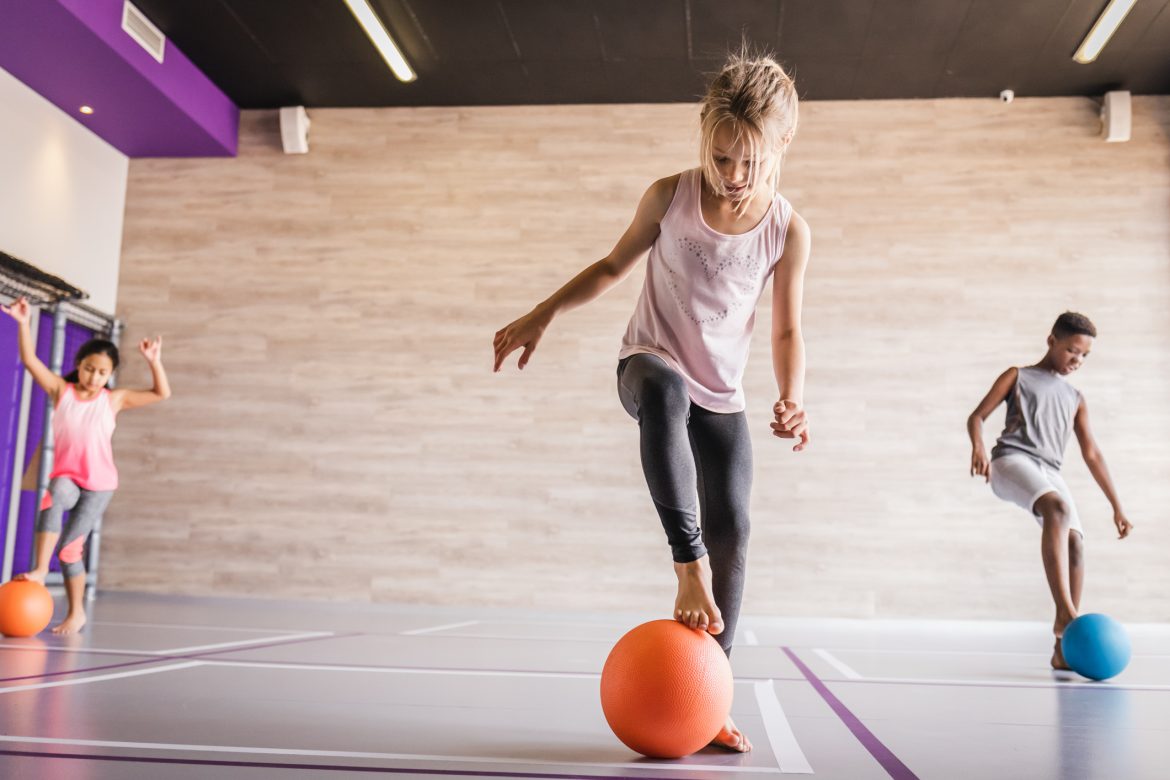The World Health Organisation recommends at least 60 minutes of moderate to vigorous physical activity for children each day. The following exercises can be broken up into ‘bite size’ intervals that can be done in between school lessons or other activities. These are the types of fun exercises children can partake in at home or at Virgin Active’s kids facilities or in-studio, such as Game On and BOOST, for 8-13 year olds.
Twist and throw
To practise twisting and the use of oblique muscles on the sides of their tummies, ask your child to stand close to a wall, with their side facing the wall. They must take a soccer ball (or similar sized ball) and twist their body to throw the ball against the wall and catch it again. Do this a few times on one side, before turning to do it on the other side.
Colour push-ups
This exercise works on upper body strength, as well as colour recognition, memory, , and improving coordination. .
Ask your child to get into the push-up position. Place three or four coloured rings or pieces of paper around them. Call out a colour sequence, for example: purple, green, yellow, green and so on). Your child, remaining in the push-up position, must use one hand to touch each colour in that order.
Make the sequence more difficult for older children. For example: Red, blue, red, yellow, green, yellow, blue.
Spelling pull
To practise pulling, your child must stand near a pillar with their feet shoulder-width apart. Wrap a bath towel around the pillar. Let the child hold each end in a hand and lean backwards with their arms straight out. Stand behind should they lose their balance.
Then, call out words that form part of your child’s spelling homework. As your child spells out each letter, they must pull themselves towards the pillar until their hands reach their ribs, and then slowly back again.
Squatting maths
This activity requires your child to squat (or choose their favourite activity of choice) as they practise their maths. Younger children can use addition and subtraction for this activity – ask them to count out loud, while older children can recite their times tables.
With each squat or activity, ask your child to verbalise the sum. For example: squat (1), squat (plus 2), squat (equals 3). Or, squat (10), squat (times 6), squat (equals 60).
Lunging letters
Get your child to recite the alphabet, doing a deep lunge for each letter. Make sure that the back leg stays straight and stationary as the child steps forward with the other leg.
You will need to do this exercise in a long passage, driveway or garden. Don’t worry if the child has to turn around a few times – it’s all part of the fun! Older children can spell out the words they are learning at school.
Drop and go
This fun activity promotes agility, speed and reaction time. You need at least two participants, plus a stick or broom for each of them. Get the participants to stand about two metres apart, holding their stick upright in front of them. Call out ‘ready, set, go’. On ‘go’, the participants must let go of their sticks and run to catch the other participants’ stick before it hits the ground. The last standing stick is the winner.
Energetic equations
Write down a list of maths equations suitable for your child’s age, whether it involves addition, subtraction, multiplication or division – or a combination of these. The answer to the equation is the number of exercises (burpees, squats, push ups, lunges and so on) your child will have to do, for example, 27 – 18 = 9 burpees. After each set ask them to work out the next equation and do the corresponding number of burpees.
Burpees are great for developing power. To do one, stand in a squat position with feet shoulder-width apart and hands on the floor between your feet. Kick your feet back so that you’re in the push-up position with your weight on your hands. Do one push up, then jump your feet back to their starting position. Jump into the air and clap your hands above your head, landing back in the squat position.
To make this activity more diverse, swap out burpees with squats, push ups, lunges, jumping jacks or other fun activities.
Jumping and dodging
Use this jumping and dodging exercise to practise quickness. You’ll need two people for this activity. Gather a whole basket of different sized balls. Use scrunched up paper if you don’t have enough balls.
One person must take the basket and stand a few metres away from the other. Then roll/throw the balls along the ground as quickly as possible towards the feet of the other person. The second person must dodge the balls so that they don’t touch their feet.
The two people can take turns to throw and dodge as this exercise promotes foot-eye coordination for the dodger, hand-eye coordination for the thrower, and motor planning and reaction time for both.
For more fun-filled activities that improve your child’s physical development, visit the kids blog page on the Virgin Active website.
ALSO SEE A FUN AND SIMPLE WAY TO TEACH KIDS ABOUT MONEY

